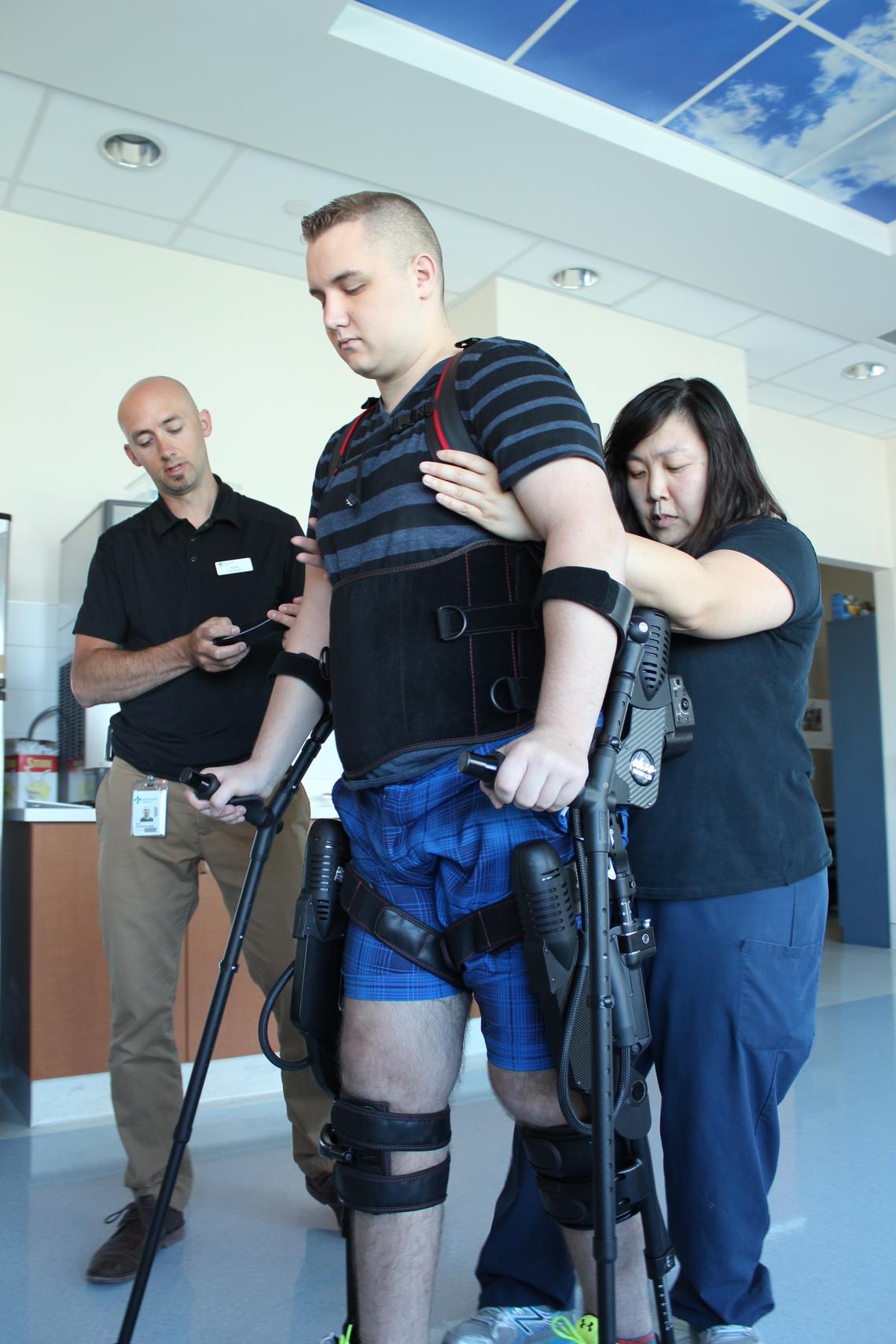Aug. 3, 2016
Spinal cord injury patients may benefit from using exoskeleton earlier in treatment

Kyle McIntosh, left, and Olivia Dong, right, help spinal injury patient Alex.
Researchers from the University of Calgary’s Cumming School of Medicine are the first in Canada to examine the benefits of using an exoskeleton robotic device to rehabilitate patients with spinal cord injuries (SCI) in the days and weeks following their injury.
While previous studies have examined the benefits of using exoskeletons months or years after an injury, this is the first study to look at the benefits so early during recovery.
“The first nine months after a spinal cord injury are pivotal to recovery, so we want to attempt to introduce rehabilitation and mobilization early on and see if it makes a difference,” says lead investigator Dr. Chester Ho, associate professor in the university’s Department of Clinical Neurosciences and member of the Hotchkiss Brain Institute.
The device, known as the Ekso Bionic Exoskeleton, consists of a metal frame that supports and stabilizes a patient’s torso, core, legs and feet. It is moved robotically by a therapist, enabling patients with a spinal cord injury to get up and walk around. Although it is controlled by remote control, the device offers varying levels of physical control by the patient, depending on the nature and extent of their injury.
Potential to reduce injury-related complications
Ho says exoskeletons may potentially promote recovery and reduce complications in SCI patients by reducing loss of bone and muscle mass caused by spending so much time lying down, and also improve breathing and bowel function.
“When it comes to rehabilitation, we often tell people, ‘If you don’t use it, you lose it,’” says Ho, who is also a member of the O’Brien Institute for Public Health.
Exoskeletons have typically been used in rehabilitation months after an SCI because patients may have other medical conditions or complications shortly after their SCI, or may experience rapidly dropping blood pressure when they stand up.

Dr. Chester Ho, associate professor in the university’s Department of Clinical Neurosciences.
However, Ho says the device may be appropriate earlier in the recovery of some patients.
“We believe that taking advantage of exoskeletons early will give many patients the best possible chance at recovery,” he says.
The year-long study, which begins this summer, will include between five and 10 patients selected from across Calgary. It aims to examine whether treatment is safe and feasible in the days and weeks after an SCI. This study will be followed by larger studies involving more patients.
Participants in the study will receive 60-minute therapy sessions with the exoskeleton device two to three times a week, for a total of 25 training hours over an eight- to 10-week period. Safety and feasibility outcomes will be monitored and tracked by the research team throughout all sessions.
Hope for the future
Before the advent of exoskeletons, rehabilitation for patients with an SCI required them to be hoisted with a physical therapist moving their legs.
“The exoskeleton lets patients take actual steps, which is not only more realistic but much less cumbersome,” says physical therapist Kyle McIntosh.
“Every step is different with this device, so patients learn from their mistakes in real time. Patients really like to use the device; it gives them hope.”
Alex, 15, sustained a spinal cord injury while tobogganing last December.
He says rehabilitation sessions with the exoskeleton have made a difference in how he feels and gives him hope for the future.
“It was amazing to be walking again,” Alex says. “It really did a lot for my mental and emotional well-being, not to mention the huge health benefit of being vertical. I remember the first time standing up. Kyle said, ‘Wow, now we can see how tall you are.’ This gave me something fun and exciting to look forward to every week in a time when I was dealing with a great deal of loss.”
